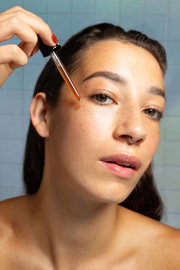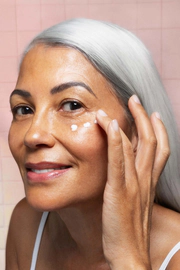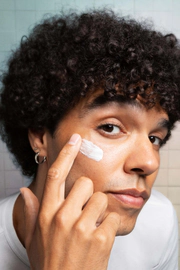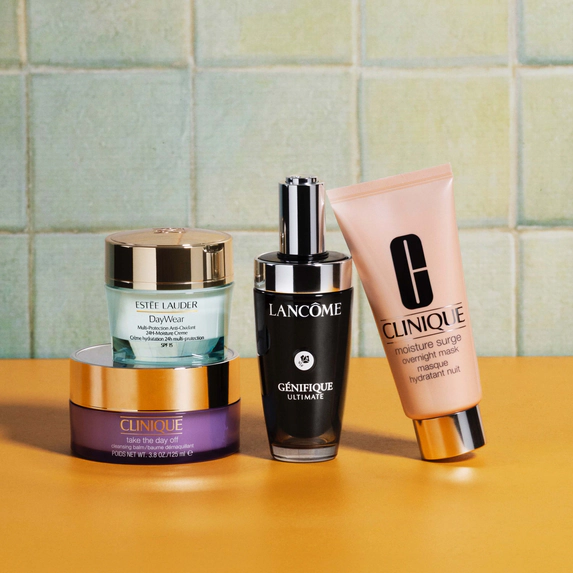Your Everyday Skincare Routine For Sensitive Skin
Ever feel like you’re playing roulette with your sensitive skincare routine? You’re not alone. Finding a reliable daily routine for sensitive skin can be tricky, especially as everyone’s experience of skin sensitivity is unique. That’s where knowledge comes in. Yep, knowledge is the ultimate active ingredient when caring for sensitive skin – or any skin type, for that matter.
Get to know your skin and its triggers, and you’ll find it much easier to choose the right skincare products for you. Scroll our skincare guide for sensitive skin, backed by Dermatologist Dr Cara McDonald, to learn how to care for sensitive skin and what to look for when identifying your skin’s needs.
Step 1: Cleanse
Cleansing is important for sensitive skin as it removes excess dirt and makeup to keep skin clear and healthy. Reach for products that contain calming ingredients like chamomile, aloe vera and hyaluronic acid. But stay away from alcohol, artificial fragrances and harsh exfoliants, as these ingredients can dry out and irritate the skin further.
How to apply cleaners to sensitive skin:
Step 1: Wet face with warm water
Step 2: Massage a 10c coin-sized amount into the face and neck in a circular motion
Step 3: Rinse with cool water
Step 4: Pat skin dry to prep for the next step
Apply once a day in the evening for super-sensitive skin. Or twice daily with a gentle product.
Step 2: Use Alcohol-Free Toner
Choose a toner specially formulated to soothe sensitive skin. It’ll remove any impurities your cleanser has missed while locking in moisture and calming your skin. Like cleansers, stay away from toners that contain alcohol or artificial fragrance, as these can dry out and irritate sensitive skin.
How to apply toner to sensitive skin:
Step 1: Apply a small amount of toner to a cotton ball or pad
Step 2: Rub gently over the face using an upward motion
Step 3: Leave for a minute or two to dry for maximum efficacy before applying the next product
Apply once a day in the evening after cleansing for super-sensitive skin. Otherwise, twice daily.
Step 3: Apply Serum
Serums are great at keeping skin hydrated, which is especially important for sensitive skin. Why? Because hydrated skin is better at combating irritants and soothing inflammation. Reach for serums that contain nourishing yet calming ingredients like hyaluronic acid, ceramides, niacinamide and centella asiatica. However, ingredients such as salicylic acid, retinol, and Vitamin C can increase sensitivity levels, so it’s best to stay clear of these.
How to apply serum to sensitive skin:
Step 1: Mist or dampen the face first for maximum efficacy
Step 2: Add a pea-sized amount to your palms and rub your hands together
Step 3: Gently apply to the face using small tapping motions with your fingertip or palm
Apply morning and night.
Step 4: Moisturise
Locking in moisture is key to looking after sensitive skin since dehydration may increase irritation levels. In saying that, even some moisturisers can trigger sensitivity. So, stick with a fragrance-free, non-comedogenic product specifically for sensitive skin. The best moisturisers for sensitive skin contain soothing ingredients like squalane, niacinamide, ceramides, cica and aloe vera.
How to apply moisturiser to sensitive skin:
Step 1: If using a serum, apply moisturiser to the skin before it dries
Step 2: Dot around the face, applying a little extra in high-sensitivity areas
Step 3: Gently rub into the skin using an upward motion
Step 4: Leave to dry before applying SPF or makeup
Apply morning and night.
Step 5: Finish With SPF
Aside from protecting your skin from Australia’s strong rays, wearing an SPF daily (of at least 30) can also reduce sensitivity. That’s because exposure to UV rays can cause more inflammation, irritation, and dehydration. If you have super sensitive skin, look for an SPF that contains minerals rather than chemicals. Why? Because the heat that’s generated as chemical SPF deactivates UV rays can trigger skin irritation.
How to apply SPF to sensitive skin:
Step 1: Dot SPF on forehead, nose, cheeks, chin, and neck with fingertips
Step 2: Rub gently into the skin to achieve even coverage
Apply daily in the morning after moisturiser and before makeup, even in the winter.
Sensitive Skin 101
By soaking up a little knowledge about sensitive skin, you can make that seesaw much easier to balance. Read on to learn how.
Defining Sensitive Skin - So, what is sensitive skin, anyway? It’s skin that reacts to the application of various products like alcohol-based gels, exfoliants, soaps and scented formulas, which can be harder to tolerate. And the symptoms aren’t fun (as you may know). Think: tingling, burning, stinging, redness, dryness and peeling.
What Causes Sensitive Skin - There are various causes for sensitive skin, including genetics, environmental factors, allergies, and harsh skincare products. Climate can also be a trigger, with some being more sensitive at certain times of the year. Others also don’t tolerate certain ingredients - like alcohol-based gels, exfoliants and artificial fragrances.
Calming Sensitive Skin - Being deliberate with your choice of skincare products can go a long way to calming and protecting sensitive skin. Hunt for mild skincare products – with plenty of hydration - and apply them gently as part of a daily skincare routine that’s tailored to your sensitivity levels. Pat your skin dry (instead of rubbing), and try not to over wash your skin.
Sensitive Skin Tips
While sensitive skin can be uncomfortable, knowing how to care for it and what skincare products to use can calm and protect it from becoming re-sensitised.
Know Your Ingredients - Knowledge is the ultimate active ingredient when it comes to caring for sensitive skin. Why? Because the more you know about what’s going into your face, the easier it is to identify skincare products that trigger. Always opt for gentle ingredients over harsh chemicals. And look out for hero ingredients like hyaluronic acid, chamomile, aloe vera, ceramides and niacinamide.
Use Lukewarm Water - Lukewarm water is much gentler on your skin than hot water - which can strip your skin of its protective oils that hold moisture. And for sensitive skin types, this can increase irritation further. Lukewarm water will still remove impurities without damaging your skin. Want to go a step further? Rinse with cold water after cleansing to tighten pores and promote blood circulation.
Gentle Exfoliants - News flash: Sensitive skin can be exfoliated. In fact, a gentle, non-abrasive exfoliating product can smooth and soften your complexion and stimulate blood flow to improve its health. Although, it’s smart to stay away from super-strength exfoliators with harsher acids (as these can penetrate the skin’s surface and increase irritation). And careful not to overdo it – once a week max.
Skincare Routines For Every Skin Type
Our skin changes all the time, especially in Australia’s unique climate. So, we’ve created guides for each skin type to help you crack your skin code and prepare for all life’s moments.







